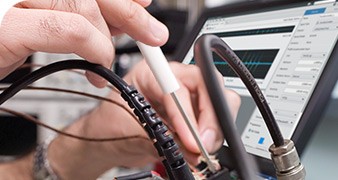LabVIEW Core 1 Course Overview
In the LabVIEW Core 1 Course, you will explore the LabVIEW environment and interactive analysis, dataflow programming, and common development techniques in a hands-on format. In this course, you will learn how to develop data acquisition, instrument control, data-logging, and measurement analysis applications. At the end of the course, you will be able to create applications using the state machine design pattern to acquire, analyze, process, visualize, and store real-world data.
Available formats
Course Objectives
-
Interactively acquire and analyze single-channel and multi-channel data from NI DAQ devices and non-NI instruments
-
Create user interfaces with charts, graphs, and buttons
-
Use programming structures, data types, and the analysis and signal processing algorithms in LabVIEW
-
Debug and troubleshoot applications
-
Log data to file
-
Use best programming practices for code reuse and readability
-
Implement a sequencer using a state machine design pattern
Course Details
Duration
-
Instructor-led Classroom: Three (3) days
-
Instructor-led Virtual: Five (5) days, five-and-a-half-hour sessions
-
On-Demand: 7.5 hours (exercises as a supplement)
Audience
-
New users and users preparing to develop applications using LabVIEW
-
Users and technical managers evaluating LabVIEW in purchasing decisions
-
Users pursuing the Certified LabVIEW Associate Developer certification
Prerequisites
-
Experience with Microsoft Windows
-
Experience writing algorithms in the form of flowcharts or block diagrams
NI Products Used
If you take the course On-Demand:
-
LabVIEW 2021 or later
-
NI-DAQmx 21.0 or later
-
NI-488.2 21.0 or later
-
NI VISA 21.0 or later
-
USB-6212
-
BNC-2120
If you take the course in an instructor-led format:
-
LabVIEW 2023 or later
-
NI-DAQmx 23.0 or later
-
NI-488.2 23.0 or later
-
NI VISA 23.0 or later
-
USB-6212
-
BNC-2120
Training Materials
-
Virtual instructor-led training includes digital course material that is delivered through the NI Learning Center.
-
NI virtual instructor-led training is delivered through Zoom, and Amazon AppStream/LogMein access is provided to participants to perform the exercises on virtual machines equipped with the latest software.
Cost in Credits
-
On-Demand: Included with software subscription and enterprise agreements, or 5 Education Services Credits, or 2 Training Credits
-
Public virtual or classroom course: 30 Education Services Credits or 9 Training Credits
-
Private virtual or classroom: 210 Education Services Credits or 60 Training Credits
LabVIEW Core 1 Course Outline
| Lesson | Overview | Topics |
|---|---|---|
Introduction to LabVIEW | Explore LabVIEW and the common types of LabVIEW applications. |
|
First Measurement | Use NI Data Acquisition (DAQ) devices to acquire data into a LabVIEW application. |
|
Exploring an Existing Application | Explore an existing LabVIEW project and parts of a VI. |
|
Creating Your First Application | Build a VI that acquires, analyzes, and visualizes data from NI DAQ device as well as from a non-NI instrument. |
|
Exploring LabVIEW Best Practices | Use various help and support materials provided by NI, explore resources, tips and tricks for using LabVIEW. |
|
Debugging and Troubleshooting | Explore tools for debugging and troubleshooting a VI. |
|
Executing Code Repeatedly Using Loops | Explore components of LabVIEW loop structures, control the timing of a loop, and use loops to take repeated measurements. |
|
Working with Groups of Data in LabVIEW | Work with array and waveform data types, single-channel and N-channel acquisition data. |
|
Writing and Reading Data to File | Explore basic concept of file I/O and how to access and modify file resources in LabVIEW. |
|
Bundling Mixed Data Types | Use LabVIEW to bundle data of different data types and pass data throughout your code using clusters. |
|
Executing Code Based on a Condition | Configure Case structure and execute code based on a condition. |
|
Reusing Code | Explore the benefits of reusing code and create a subVI with a properly configured connector pane, meaningful icon, documentation, and error handling. |
|
Controlling Data Type Changes | Propagate data type changes using type definitions. |
|
Implementing a Sequencer | Sequence the tasks in your application by using the State Machine design pattern. |
|
First Measurement (Non-NI Instrument) | Use LabVIEW to connect to non-NI instruments and validate the results. |
|
Continue Your Learning Path
LabVIEW Core 2
Use common design patterns to implement and distribute LabVIEW applications.
Data Acquisition Using NI-DAQmx and LabVIEW
Programmatically measure, generate, and synchronize data acquisition tasks.
Developing Embedded Applications Using CompactRIO and LabVIEW Real-Time
Design, prototype, and deploy a reliable Real-Time application using NI compactRIO.
Upgrade to Membership
If you are planning to take three or more NI instructor-led courses within one year, a Training Membership provides cost-effective, unlimited access to all NI public classroom and public virtual courses, along with unlimited certification vouchers.


